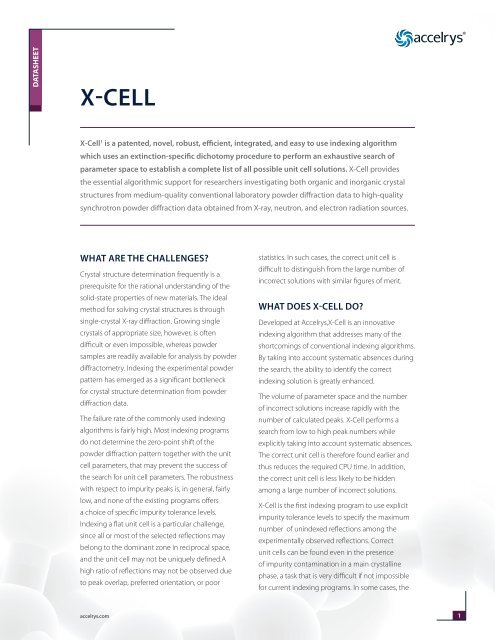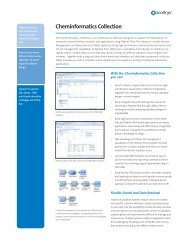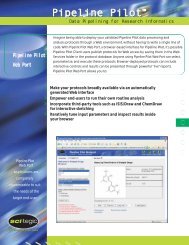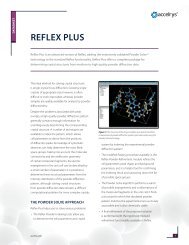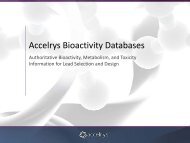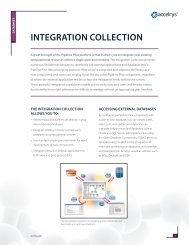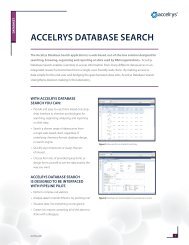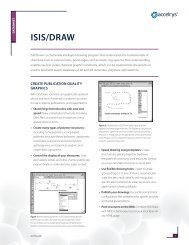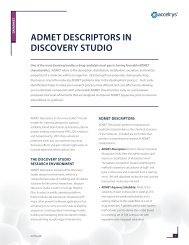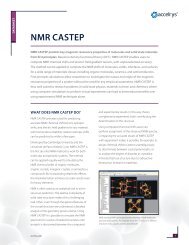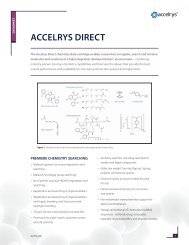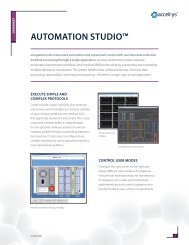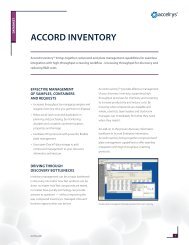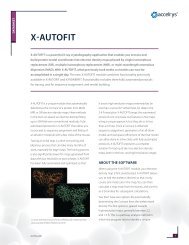X-cell - Accelrys
X-cell - Accelrys
X-cell - Accelrys
Create successful ePaper yourself
Turn your PDF publications into a flip-book with our unique Google optimized e-Paper software.
DATASHEET<br />
X-<strong>cell</strong><br />
X-<strong>cell</strong>1 is a patented, novel, robust, efficient, integrated, and easy to use indexing algorithm<br />
which uses an extinction-specific dichotomy procedure to perform an exhaustive search of<br />
parameter space to establish a complete list of all possible unit <strong>cell</strong> solutions. X-Cell provides<br />
the essential algorithmic support for researchers investigating both organic and inorganic crystal<br />
structures from medium-quality conventional laboratory powder diffraction data to high-quality<br />
synchrotron powder diffraction data obtained from X-ray, neutron, and electron radiation sources.<br />
What are the challenges?<br />
Crystal structure determination frequently is a<br />
prerequisite for the rational understanding of the<br />
solid-state properties of new materials. The ideal<br />
method for solving crystal structures is through<br />
single-crystal X-ray diffraction. Growing single<br />
crystals of appropriate size, however, is often<br />
difficult or even impossible, whereas powder<br />
samples are readily available for analysis by powder<br />
diffractometry. Indexing the experimental powder<br />
pattern has emerged as a significant bottleneck<br />
for crystal structure determination from powder<br />
diffraction data.<br />
The failure rate of the commonly used indexing<br />
algorithms is fairly high. Most indexing programs<br />
do not determine the zero-point shift of the<br />
powder diffraction pattern together with the unit<br />
<strong>cell</strong> parameters, that may prevent the success of<br />
the search for unit <strong>cell</strong> parameters. The robustness<br />
with respect to impurity peaks is, in general, fairly<br />
low, and none of the existing programs offers<br />
a choice of specific impurity tolerance levels.<br />
Indexing a flat unit <strong>cell</strong> is a particular challenge,<br />
since all or most of the selected reflections may<br />
belong to the dominant zone in reciprocal space,<br />
and the unit <strong>cell</strong> may not be uniquely defined.A<br />
high ratio of reflections may not be observed due<br />
to peak overlap, preferred orientation, or poor<br />
accelrys.com<br />
statistics. In such cases, the correct unit <strong>cell</strong> is<br />
difficult to distinguish from the large number of<br />
incorrect solutions with similar figures of merit.<br />
What does X-<strong>cell</strong> do?<br />
Developed at <strong>Accelrys</strong>,X-Cell is an innovative<br />
indexing algorithm that addresses many of the<br />
shortcomings of conventional indexing algorithms.<br />
By taking into account systematic absences during<br />
the search, the ability to identify the correct<br />
indexing solution is greatly enhanced.<br />
The volume of parameter space and the number<br />
of incorrect solutions increase rapidly with the<br />
number of calculated peaks. X-Cell performs a<br />
search from low to high peak numbers while<br />
explicitly taking into account systematic absences.<br />
The correct unit <strong>cell</strong> is therefore found earlier and<br />
thus reduces the required CPU time. In addition,<br />
the correct unit <strong>cell</strong> is less likely to be hidden<br />
among a large number of incorrect solutions.<br />
X-Cell is the first indexing program to use explicit<br />
impurity tolerance levels to specify the maximum<br />
number of unindexed reflections among the<br />
experimentally observed reflections. Correct<br />
unit <strong>cell</strong>s can be found even in the presence<br />
of impurity contamination in a main crystalline<br />
phase, a task that is very difficult if not impossible<br />
for current indexing programs. In some cases, the<br />
1
dominant phase of mixtures can be indexed in the presence of<br />
even up to 50% impurity peaks if high-quality synchrotron data<br />
are available.<br />
For a given range of allowed calculated peak numbers, a given<br />
pattern of systematic absences, and a given impurity tolerance<br />
level, an exhaustive search is performed using a successive<br />
dichotomy procedure. Zeropoint shift is determined along with<br />
unit <strong>cell</strong> parameters. All indexing solutions are fully optimized,<br />
compared, and ranked according to a relative figure of merit<br />
Fr. Fr favors solutions with low numbers of calculated peaks,<br />
adjustable parameters, and impurity peaks. Indexing of long and<br />
flat unit <strong>cell</strong>s is facilitated by the ability to search for rows (1D) or<br />
zones (2D) in reciprocal space first, and then the search is refined<br />
using the lattice parameters of the dominant row or zone in the<br />
final unit <strong>cell</strong> (3D) search in combination with a modified Pawley<br />
refinement2 .<br />
The main advantages of X-Cell are completeness and robustness.<br />
Regardless of whether or not a promising unit <strong>cell</strong> has already<br />
been found, the algorithm continues to search larger and larger<br />
portions of parameter space until the search is complete or<br />
interrupted by the user. Initial validation1 indicated that XCell has<br />
a higher success rate (92%) than DICVOL3 (46%), TREOR4 (46%),<br />
and ITO5 (33%) for 24 representative cases. X-Cell copes very well<br />
with various difficulties that are typically encountered in powder<br />
indexing, including contamination with impurity phases, strong<br />
peak overlap, peak position errors, zero-point shift and extreme<br />
<strong>cell</strong> geometries. Implementation of the successive dichotomy<br />
approach is significantly more efficient in X-Cell than in DICVOL3.<br />
the Material studio advantage<br />
X-Cell is implemented in Reflex, operated within the Materials<br />
Studio® software environment. Materials Studio’s integrated<br />
model building and editing tools enable you to construct,<br />
visualize, and manipulate structures of crystalline solids (e.g.,<br />
drugs, pigments, metals, metal oxides, zeolites, etc.) using<br />
Materials Visualizer. Results obtained by indexing are readily<br />
passed on to other modules in Reflex and Reflex Plus for a full<br />
structure solution determination. It is easy to produce high quality<br />
images. Structural information and diffraction data can be readily<br />
exported to and imported from other PC applications - allowing<br />
you to share them with colleagues and perform further analysis<br />
using a spreadsheet and other packages.<br />
accelrys.com<br />
Diagram 1: Workflow of X-Cell<br />
DATASHEET: mATEriAlS STuDio<br />
Figure 1: The Materials Studio interface displaying an experimental X-ray powder diffraction<br />
pattern and the X-Cell control panels<br />
2
hoW does X-<strong>cell</strong> Work?<br />
The task of indexing involves finding a unit <strong>cell</strong> for which the<br />
calculated 2Θ positions of the diffraction peaks match the<br />
experimentally observed peak positions. Diagram 11 illustrates<br />
the workflow of X-Cell.An example of inputs for X-Cell calculations<br />
is shown in Figure 1. The correctness of a unit <strong>cell</strong> solution can be<br />
verified easily through a Modified Pawley Refinement as indicated<br />
in Figure 2.<br />
Features<br />
• Reads in a variety of diffractometer file formats including Bruker,<br />
Stoe, Scintag, Jade, Philips, JCAMP, Galactic SPC, GSAS raw, ILL,<br />
PAnalytical XRDML<br />
• Allows for different X-ray sources with arbritary wavelengths.<br />
• Suitable for X-ray, neutron, and electron diffraction<br />
• Ability to pre-process experimental data, for example via<br />
background subtractions, data interpolation, data smoothing,<br />
data scaling, and Kα2 strippings<br />
• Manual or automatic peak identification<br />
• Choice of peak search methods - simple or Savitsky Golay<br />
• Choice of dimensionality search on rows (1D), zones (2D), and<br />
unit <strong>cell</strong> (3D)<br />
• Eight different impurity tolerance levels control allowable<br />
impurity peaks among the experimentally observed peaks<br />
• Two impurity modes to enable searches at an allowed impurity<br />
tolerance level only, or in parallel at all impurity levels up to the<br />
allowed maximum<br />
• Can handle any possible space group, both standard and nonstandard<br />
settings, accounting for systematic absences<br />
• Controls the bounds of the search dimension by setting target<br />
values and allowed errors for one or three lattice parameters<br />
• User-defined highest allowed number of calculated peaks<br />
reFerences:<br />
accelrys.com © 2011 <strong>Accelrys</strong> Software Inc. All brands or product names may be trademarks of their respective holders.<br />
DATASHEET: MATERIALS STUDIO<br />
Figure 2: Correct unit <strong>cell</strong> obtained from X-Cell confirmed with a Modified<br />
Pawley Refinement<br />
• Ability to set expected zero-point shift and the range for the<br />
zero-point search<br />
• Full interactivity with powder pattern and data in table format<br />
• Returns unit <strong>cell</strong> parameters, figures of merit, a stability<br />
parameter,number of impurity peaks,number of observed<br />
peaks, number of calculated peaks not overlapped with<br />
observed peaks, zero-point shift, average 2Θ deviations trial<br />
• Enables construction of a unit <strong>cell</strong> from any successful solution,<br />
for further analysis with Reflex tools<br />
• Benefits from straightforward interaction with other Materials<br />
Studio products as well as other PC applications<br />
systeM details<br />
Operated through the Materials Studio user interface on<br />
Windows® 2000 and XP, X-Cell calculations can be executed on<br />
Windows 2000, 2003, XP, SGI IRIX, Red Hat Linux (Intel IA32, Intel<br />
IA64, EM64T, and compatibles), SuSe Linux (Intel IA32, EM64T, and<br />
compatibles), and HP Tru64 operating systems.<br />
To learn more about Materials Studio, go to<br />
accelrys.com/materials-studio<br />
1. M.A.Neumann, J. Appl. Cryst., 2003, 36, 356-365.<br />
2. G.E. Engel, S.Wilke, O. Konig, K.D.M. Harris, and F.J.J. Leusen, J. Appl. Cryst., 1999, 32, 1169-1179.<br />
3. A. Boultif and D. Louer, J. Appl. Cryst., 1991, 24, 987-993.<br />
4. P.E.Werner, L. Ericksson and M.Westdahl, J. Appl. Cryst., 1968, 1, 108-113.<br />
5. J.W.Visser, J. Appl. Cryst., 1969, 2, 89-95.<br />
DS-8060-0811<br />
3


